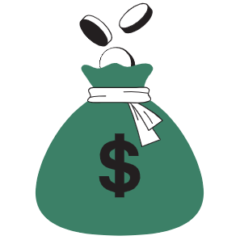Reserves as in safe. Reserves as in accessible. Reserves as in durable.
There is nothing safer than cash. There is nothing more accessible than cash. And if done right, there is nothing more durable than cash.
And by done right means that the quantity of reserves matches the duration required of those reserves.
For most, that duration is three to six months’ worth of living expenses. That is not gross income, that is not net income but expenses. You need that many months of expenses set aside to tide you through in case of things like a job loss etc.
Situations like rental property ownership might require more in reserves but for many, three to six months of expenses set aside is plenty.
Any cash beyond that belongs in investments. It must or inflation will slowly and then suddenly chomp away at your hoard. That is compound interest working in reverse.
On where to park those reserves, a high-yield savings account will continue to remain an ideal place as immediate access to cash is needed.
But I prefer a better option and that is buying Series-I savings bonds. The “I” in Series-I stands for inflation-indexed which means you get to preserve the long-term purchasing power of your money.
And it gets better as there are two parts to the interest income you earn on these bonds:
- The fixed-rate part which remains fixed for the life of each new bond you buy.
- The inflation-indexed part which changes twice a year (in May and in November) based upon inflation rate.
And both parts that make up the interest income get automatically reinvested until you redeem (sell) the bonds or when the bonds mature (in 30 years). This is compound interest working for you.
You can check on the latest rates here.
And then the perks:
- No state or local income taxes on the interest earned, ever.
- No Federal income tax until the bonds are redeemed or mature.
That is all super but there are a few catches:
- You only get to buy up to $10,000 worth of these bonds for each person, each year. Bring in a partner and we are talking $20,000 annually. I consider that plenty for a year
- Once you buy these bonds, you will not be able to redeem them for the first 12 months.
- And if you do redeem them before the 5-year anniversary of the purchase date of each new I-bond, you forfeit the last three months of interest as penalty.
But assuming you can plan around these inconveniences, I would do the bond buying for a few years between you and your partner and that is all the emergency stash you’ll ever need.
But there is another interesting take on these that I’ll personally employ if I were say a decade away from retiring. This is of course surplus cash that I get to use to purchase insurance to protect against something called the Sequence of Returns risk.
Sequence of Returns risk is retiring into a bad phase in the markets so if you happen to encounter one, you can draw down this bond buffer while you wait for the markets to recover.
Buying these bonds or any bonds for that matter, is not a get rich quick scheme. The right kind of bonds, which I-bonds happen to be, protects your purchasing power while insuring against the risk I just described.
And regardless of what anyone says, insurance is an expense. You give up on growth buying these bonds instead of say investing in the stock market.
You can buy these bonds at treasurydirect.gov. You’ll need a separate account for your partner.
But back to the essence of maintaining reserves, get to that stash first before doing anything else. That of course assumes you don’t carry any debt but if you do, extinguish that first before getting to the reserves.
But get there you must.
Thank you for your time.
Cover image credit – Photomix Company, Pexels

